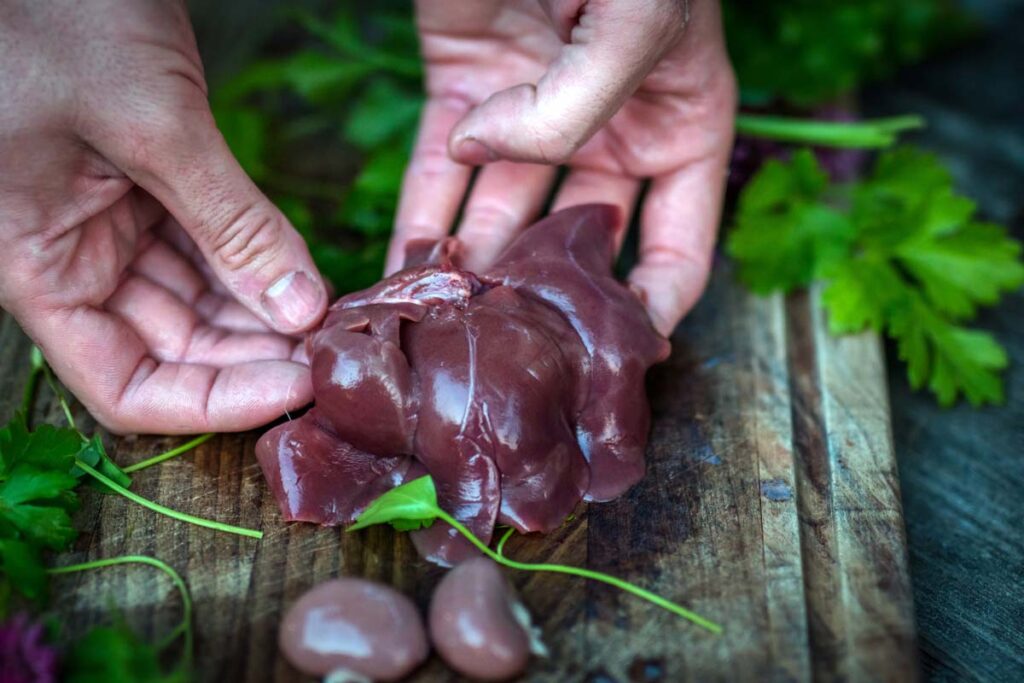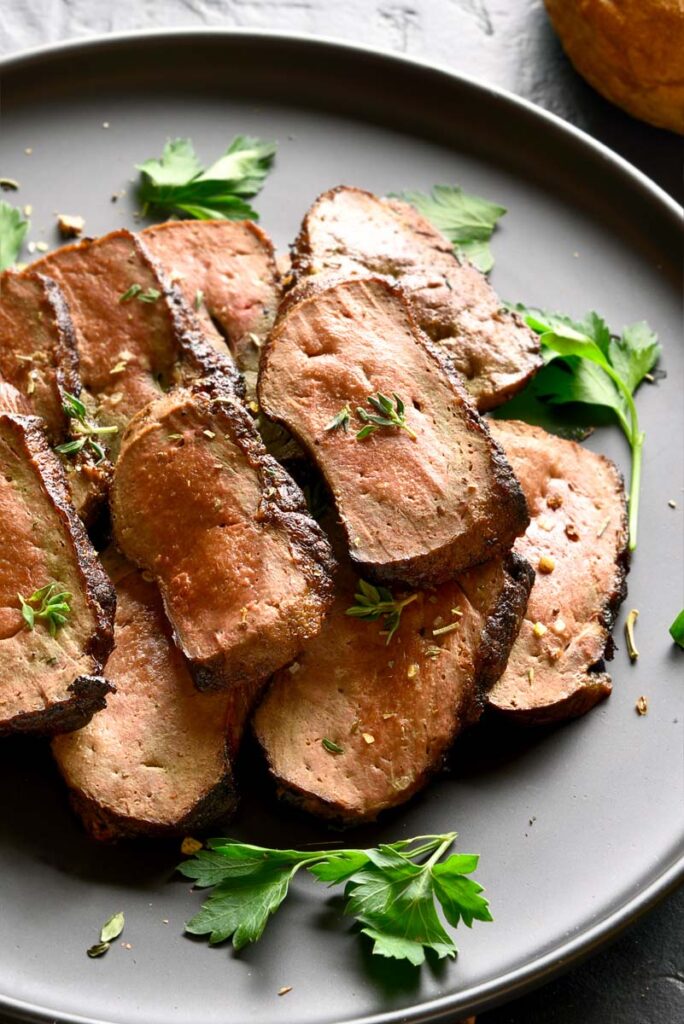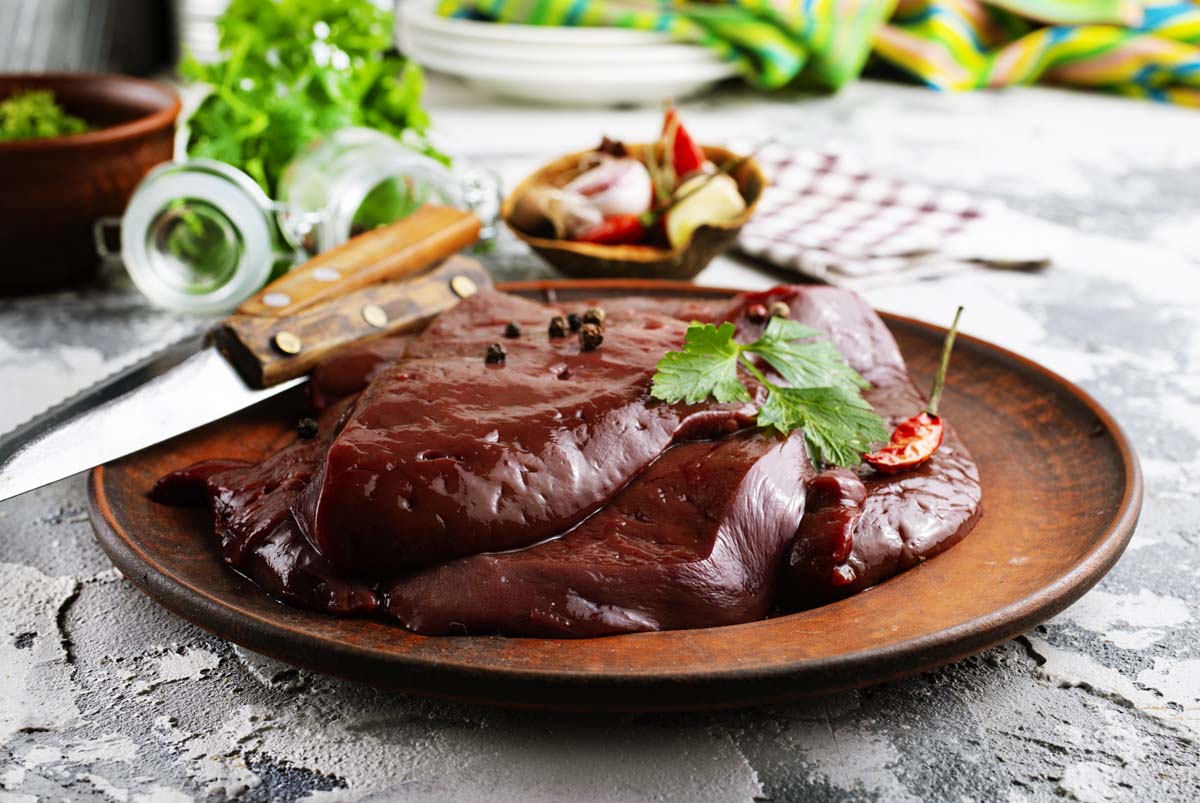Can I eat raw liver?
The liver is nutritious and by many considered a delicious food but it is not recommended to be eaten raw.
When an animal is slaughtered, there is always some contamination of the liver. Some leakage occurs when the oesophagus is cut to remove the heart, lungs and liver from the carcass, and some contamination of the liver by bacteria from the animal’s stomach, intestines and fur occurs when it is handled at the abattoir. The contamination is often so small that it cannot be seen with the naked eye, but there is plenty of bacteria on the surface of the raw liver.
Not all bacteria are harmful to humans, but animals sometimes carry bacteria that could make humans ill.
The most common bacteria present in animals that, if not eliminated, can cause serious illness in humans include Salmonella, VTEC (Verotoxin producing Escherichia Coli), and Campylobacter. Nevertheless, with good knowledge of how to prepare food and maintain good hygiene in the kitchen, you can enjoy good food with a minimal risk of food poisoning.
Important to know about the liver is therefore that raw liver is contaminated with bacteria on the surface. Even the inside of the liver can contain bacteria that can make people sick. Some types of Salmonella can be found in the gallbladder and can therefore also be found in the bile ducts of the liver.

These bacteria are destroyed when the liver is cooked and the temperature exceeds 158° Fahrenheit (70° C). Heating the liver before consumption is therefore an easy way to minimise the risk of food poisoning.
If, despite the risks, you still want to eat liver raw, you should at least fry the liver at a high temperature until the entire surface becomes properly heated. After that, the cooked surface can be polished away with a clean knife on a clean cutting board so that only the raw part remains. However, this is not recommended as despite this procedure, the liver can still contain harmful microorganisms.

Can I eat raw liver if I freeze it first?
Freezing the liver does not mean that the bacteria are destroyed, they remain and can begin to multiply as soon as the liver thaws again.
However, the bacterium Campylobacter is relatively sensitive to freezing. Research has shown that about 50% of these bacteria die when frozen but given that you can get sick from ingesting relatively few of these bacteria, freezing most likely means no protection against disease.
What can happen if I eat liver raw?
Raw liver always contains bacteria, some of which can be pathogenic. Whether or not you get sick and how sick you get may depend on your age, whether you are otherwise healthy, how many of these bacteria you ingest and the type of bacteria.
Common disease-causing bacteria that you can get from eating raw liver are Salmonella, VTEC and Campylobacter
Salmonella is a bacterium found in most of the world and most food-producing animals can carry the bacterium. The animal can carry the bacteria without being sick itself. The bacterium is found in the intestine, and some types can be found in the gallbladder in the liver, but it can also be present in the animal’s fur.
There are many types of Salmonella, some of which can cause serious illness in humans while others cause very mild symptoms or no symptoms at all. A common symptom in humans is diarrhoea, while a more rare but serious condition is blood poisoning, sometimes resulting in death.
VTEC (Verotoxin producing Escherichia Coli) is a bacterium that can sometimes be found in, for example, cattle and sheep and is most common in young animals. The animal usually carries the bacterium in its gut (also usually found in its fur) without being sick itself and it is likely that only a few bacteria are needed for a human to become ill.
There are many different types of VTEC, which can cause both mild and severe symptoms. Humans are affected differently, with the most serious conditions including bloody diarrhoea, brain damage or kidney damage. Deaths can occur. Young children are particularly susceptible and experience the most severe symptoms. The bacterium dies when heated, but as it only takes a few bacteria to become infected, hygiene in the kitchen is also very important.
Campylobacter is a bacterium that can be found in most food-producing animals but is particularly common in birds. The animal carries the bacterium without being sick itself. The bacteria is found in the intestines or in the animal’s fur/feathers and humans are at risk of becoming ill if good hygiene is not observed in the kitchen.
Unlike Salmonella and VTEC, many Campylobacter bacteria die when the food is frozen. Common symptoms in humans are diarrhoea, but other problems such as nerve damage can also sometimes be seen. Deaths are very rare, but the disease can in some cases cause very prolonged symptoms which can also become chronic.
Storage Guidelines: How should I store raw liver?
Raw liver is a delicate food and is quickly destroyed by microorganisms, especially if the liver’s protective membranes are damaged. Therefore, the raw liver needs to be kept cold, as close to freezing as possible, and for as short a time as possible. Raw liver should also be stored with foods that you will later heat.
Once the liver has been cooked, i.e. fried, or included as an ingredient in stews, liver pies, etc., the bacteria die. If you have cooked the liver yourself, it is important to consider cooling the dish as soon as possible and then storing it in the fridge, below 41 Fahrenheit (5°C). If you have bought a ready-made liver dish in a shop, there are instructions on the packaging to follow regarding storage, but as a rule, an opened package should be refrigerated as soon as possible to extend its shelf life.
Cooked liver should be stored in the fridge separately from raw foods such as bacon, root vegetables, etc. to avoid the risk of contamination by bacteria. This is particularly important if you do not reheat the dish before consumption.
How long does the liver keep in the fridge?
Raw liver is a delicate food and is quickly destroyed by microorganisms, especially if the liver’s protective membranes are damaged. Therefore, the raw liver needs to be kept cold, as close to freezing as possible. Under these conditions, a raw liver of normal hygienic quality can keep for a few days in the refrigerator.
Have a designated place for the raw liver in the fridge, preferably low down to avoid the risk of drips on underlying foods. Keep foods to be heated separately from foods that will be eaten as they are.
How long a previously cooked liver dish will keep in the refrigerator depends partly on how quickly the dish was chilled after cooking, whether you avoided contaminating the dish with bacteria after cooking, and the temperature and humidity in the refrigerator. If the dish has been in the fridge for a long time, a good rule of thumb is to look at and smell the food to detect any changes. The dish should only be consumed if it looks okay and does not smell or taste strange. A dish that has been stored in the refrigerator for a long time should always be thoroughly heated in all parts before consumption.
Safe Cooking: How should raw liver be handled in the kitchen?
When it’s time to cook the liver, it is important to consider keeping raw liver, including other foods that will be heated, separate from foods that will be eaten directly without cooking. This is because raw foods, especially animal foods, can be contaminated with bacteria that can make humans sick.
A good tip is therefore to start handling the food you are going to eat without heating it, for example the salad. Then continue with the liver. If you need to handle the liver alongside ready-to-eat foods – make sure you have separate cutting boards and wash your hands thoroughly before handling the ready-to-eat foods.
Ensure that cutting boards and other items that have been in contact with the liver are put in the dishwasher or washed by hand as soon as possible. Clean the sink and surfaces where the raw liver has been handled with a cloth and then wash it in a washing machine. If you have the opportunity and want to be on the safe side you can use disinfectants on the work surfaces where the liver and other raw food was handled to ensure that no bacteria remain that could later contaminate other foods and make you ill. This isn’t that difficult but will significantly reduce the risk of getting food poisoning.
What temperature should the liver be heated to?
When cooking the liver, ensure that it is heated to at least 158 degrees Fahrenheit (70°C) before consumption.
Boiling smaller pieces of liver and frying in slices reaches a sufficiently high temperature relatively quickly, while large pieces of liver need more time. To check that the temperature has been high enough – make a cut in the thickest piece of liver in the dish to check that it is no longer raw.
Is liver safe to eat?
The animal from which the liver comes must be checked at the slaughterhouse to ensure that the animal is healthy and have not been treated with drugs in an unauthorized way.
Some drugs are not allowed to be given to animals to be slaughtered for food at all because the substances are or may be harmful to humans. If an animal has been treated with these drugs, it must not be slaughtered for human consumption.
Some drugs are authorized for use in food-producing animals, some of which can be given at any time, while others cannot be given too close to slaughter, as in these cases the residues of the drugs have not yet been eliminated from the body.
As the liver acts as the body’s “purification plant”, taking care of substances that are not naturally present in the body, any drug residues are often higher in the liver than in other parts of the body.
It is advisable to choose livers from animals that are as young as possible, as heavy metals, for example, are stored in the liver and their levels increase with the age of the animal. Heavy metals found in the liver of older animals in particular include cadmium and lead.
How does liver taste?
The liver has a peculiar and rather pungent taste that people often either love or hate. The pungent taste can be softened by soaking the liver in milk for a while before cooking. Livers from younger animals usually have a less pungent taste compared to older animals.
Nutritional Value: Is Liver Healthy?
The liver is high in protein (about 20 grams per 100 grams), and low in fat and carbohydrates. The liver contains many nutrients, especially Vitamin A, but also Vitamin B1, Vitamin B2, Vitamin B3, Vitamin B6, Vitamin B9, Vitamin B12, and Vitamin C. In addition, it is rich in essential minerals such as iron, phosphorus, selenium, and zinc, as well as many important fatty acids.
Vitamin A is very important for vision and resistance to infection but is harmful in excessive doses. However, it is difficult to get too much vitamin A just by eating a lot of liver, but if you take vitamin A supplements at the same time, for example, there is a risk of overdosing. Vitamin A is harmful to fetuses in excessive doses. For this reason, pregnant women should avoid eating liver dishes and supplements containing large amounts of vitamin A. Older women can also be harmed by too much vitamin A, as research suggests that too much vitamin A can increase the risk of osteoporosis.
What is the healthiest way to eat liver? Is raw liver better than cooked?
The slight decrease in nutritional value that might occur when cooking liver should be compared with the serious risks of disease that people can suffer from if eating raw liver. The healthiest way to eat liver is to steam or boil the liver to about 158 degrees Fahrenheit (70°C) core temperature, although liver is a healthy food regardless of the type of cooking method.
Does liver lose nutrients when cooked?
The nutrient content of the liver can decrease slightly when cooking. However, the liver is a very nutritious food also after heating.
In general, it can be said that the shorter the time and the lower the temperature used in cooking, the less loss of nutrients. This means that frying or wok means most of the loss of nutrition, while steaming and boiling affect the liver’s nutritional value the least. Vitamins and minerals may leak to some extent to the dish’s liquid and thus remain in the pan, which makes it good to take care of the broth in, for example, stews. Eating the frying pad after frying is common although it may contain some harmful substances.
Quick Answers:
From which animals can I eat liver?
Eat liver from animals that have been checked at the slaughterhouse and choose animals that are as young as possible. Common animals where the liver is available for sale are beef, pork, lamb, and chicken. Goose liver is considered a real delicacy in parts of the world.
What should I consider when buying liver for consumption?
Choose livers that have been inspected and handled in approved slaughterhouses. In most countries, meat and organs from food-producing animals that have been inspected and handled in approved slaughterhouses have a special label on the packaging to show that the slaughterhouse meets the requirements for producing food that is safe to eat. In these establishments, animals are checked both before and after slaughter for the presence of disease, but there is also a check for information on whether the animals have been treated with drugs, when this was done and what type of drugs that were used.
Can I give liver raw or cooked to my dog or cat?
It is not recommended to give raw liver to dogs and cats because the raw liver can be contaminated with bacteria that can make both the dog and the cat sick. Another risk may be that the animal does not get sick but carries the bacteria and spreads them on to humans.
Most dogs like cooked liver very much. However, it is usually recommended not to give a dog liver more often than 1-2 times a week, and then not more than 10% of the whole meal, as dogs, like humans, are sensitive to large amounts of vitamin A. Liver treats are a popular snack for dogs but are rarely given in large quantities.
For cats, the same is usually said as for dogs, do not give liver more than twice a week, and vary the food to meet the cat’s nutritional needs.
How does the liver work?
The liver is an organ with many functions, located just behind the diaphragm behind the last ribs in both humans and animals. It is usually reddish-brown and shiny on the surface and consists of several different lobes. Its consistency is quite porous, not nearly as firm as, for example, a muscle. The liver is covered by a thin translucent film.
The liver works in much the same way in both animals and humans and is a very important organ with many different functions.
It produces and secretes bile, which helps to break down fat from food in the intestines so that the body can absorb it and use it. The liver handles most of the nutrients absorbed in the gut.
Another of the liver’s many functions is to deal with harmful substances we have ingested and then to help the body get rid of them. The organ also makes important proteins for the immune system and substances that allow the body to stop bleeding through coagulation.
The liver has a large reserve capacity and can function even if a large part of the organ is damaged.
